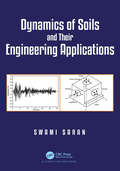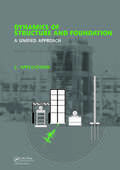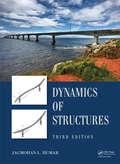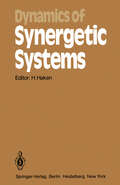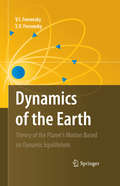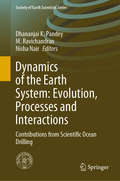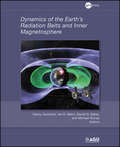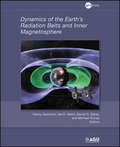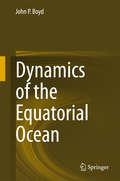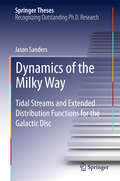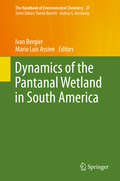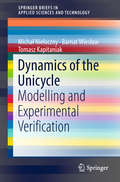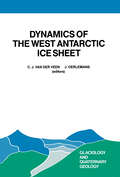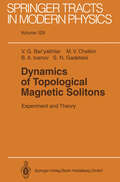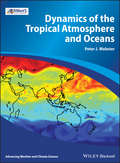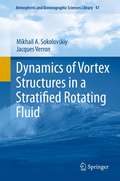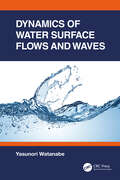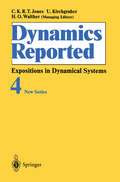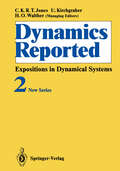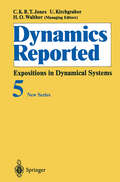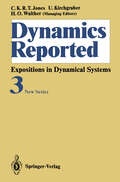- Table View
- List View
Dynamics of Soils and Their Engineering Applications
by Swami SaranThe book offers systematic dynamic analysis of soils and their engineering applications, including machine foundations, and aims to develop a clear understanding of the subject. It comprises sixteen chapters. Chapter 1 introduces the reader to the various problems in soil dynamics. In Chapter 2, concepts of theory of vibrations are discussed along with their applications in designing Vibration Absorbers and Pickups. Wave propagation in elastic medium including wave refraction in layered medium is covered in Chapter 3. Chapter 4 deals with the procedure of determining dynamic properties of soils using various laboratory and field tests. Dynamic earth pressures in retaining walls and dynamic bearing capacity of footings are dealt with in Chapters 5 and 6 respectively. Chapters 7and 8 respectively deal with dynamic behavior of pile foundations and slopes. Causes of liquefaction of soils and prediction of liquefaction potential have been discussed in Chapter 9. In Chapter 10, the procedure of estimating the unbalanced forces in various types of machines are covered. Chapters 11, 12 and 13 deal with the analysis and design of foundations of reciprocating machine, hammer, and turbo-generators respectively. In Chapter 14, problems of vibration isolation and screening are dealt with. Chapter 15 discusses the analysis and design of reinforced earth wall located in seismic areas. A new concept of a conventional rigid retaining wall having reinforced backfill is presented in Chapter 16, giving complete analysis and design procedure considering seismic forces.
Dynamics of Spatio-Temporal Cellular Structures: Henri Bénard Centenary Review (pdf) (Springer Tracts in Modern Physics #207)
by Innocent Mutabazi Jose Eduardo Wesfreid Etienne GuyonDynamics of Structure and Foundation - A Unified Approach: 2. Applications
by Indrajit Chowdhury Shambhu P. DasguptaDesigned to provide engineers with quick access to current and practical information on the dynamics of structure and foundation, this 2-volume reference work is intended for engineers involved with earthquake or dynamic analysis, or the design of machine foundations in the oil, gas, and energy sector. Whereas Volume 1 (ISBN 9780415471459
Dynamics of Structures
by J. L. HumarThis major textbook provides comprehensive coverage of the analytical tools required to determine the dynamic response of structures. The topics covered include: formulation of the equations of motion for single- as well as multi-degree-of-freedom discrete systems using the principles of both vector mechanics and analytical mechanics; free vibratio
Dynamics of Synergetic Systems: Proceedings of the International Symposium on Synergetics, Bielefeld, Fed. Rep. of Germany, September 24–29, 1979 (Springer Series in Synergetics #6)
by H. HakenThis book contains the invited papers of an international symposium on Synergetics which was held at ZIF (Center for interdisciplinary research) at Bielefeld. Fed. Rep. of Germany. Sept. 24. -29 . • 1979. In keeping with our previous meetings. this one was truly interdisciplinary. Synergetic systems are those that can produce macroscopic spatial. temporal or functional structures in a self-organized way. I think that these proceedings draw a rather coherent picture of the present status of Synergetics, emphasizing this time theoretical aspects, although the proceedings contain also important con tributions from the experimental side. Synergetics has ties to many quite different disciplines as is clearly mirrored by the following articles. Out of the many ties I pick here only one example which is alluded to in the title of this book. Indeed, there is an important branch of mathematics called dynamic systems theory for which the problems of Synergetics might become an eldorado. While, undoubtedly, a good deal of dynamic systems had been motivated by mechanics, such as celestial and fluid dynamics, theory Synergetics provides us with a wealth of related problems of quite different fields, e. g. , lasers or chemical reaction processes. In order to become adequately applicable, in quite a number of realistic cases dynamic systems theory must be developed further. This is equally true for a number of other approaches.
Dynamics of the Earth: Theory of the Planet's Motion Based on Dynamic Equilibrium
by V. I. Ferronsky S.V. FerronskyIn their search for solutions to problems concerning the dynamics of the Earth as a self-gravitating body, the authors have applied the fundamentals found in their book “Jacobi Dynamics” (1987, Reidel). First, satellite observations have shown that the Earth does not remain in hydrostatic equilibrium, which forms the physical basis of modern geodynamics. Secondly, satellite data have established a relationship between the planet’s polar moment of inertia and the potential of the Earth’s outer force field, which proves the most basic point of Jacobi dynamics. This allowed the authors to revise their derivation of the classical virial theorem, introducing the concept of a volumetric force and volumetric moment, and so to obtain a generalized virial theorem in the form of Jacobi’s equation. The main dynamical effects are: the kinetic energy of oscillation of the interacting particles, which explains the physical meaning and nature of gravitational forces; separation of shells of a self-gravitating body with respect to its mass density; differences in angular velocities of the shell’s rotation; continuity in variance of the potential of the outer gravitational force field, together with reductions in the envelope of the interacting masses (volumetric center of gravity); the nature of Earth, Moon and satellite precession; the nature and generating mechanism of the planet’s electromagnetic field; the common nature of gravitational and electromagnetic energy, and other related issues. The work is a logical continuation of the book "Jacobi Dynamics" and is intended for researchers, teachers and students engaged in theoretical and experimental research in various branches of astronomy, geophysics, planetology and cosmogony, and for students of celestial, statistical, quantum and relativistic mechanics and hydrodynamics.
Dynamics of the Earth System: Contributions from Scientific Ocean Drilling (Society of Earth Scientists Series)
by Dhananjai K. Pandey M. Ravichandran Nisha NairThis book highlights Indian scientific endeavours and contributions to answering the vast multitude of questions posed by our changing environment. The International Ocean Discovery Program (IODP) explores Earth’s history and dynamics using deep ocean drilling platforms to recover the data locked inside seafloor sediments and rocks. Since 2009, Indian scientists have been actively engaged in these expeditions. Scientists from various Earth Science disciplines have seized this opportunity to offer their expertise in order to help unravel the mysteries of the past – by delving deep into the valuable sedimentary records of our oceans. This book presents a compilation of some of their most important findings to motivate and encourage young minds for their enhanced role in the cutting edge science of ocean drilling.
Dynamics of the Earth's Radiation Belts and Inner Magnetosphere (Geophysical Monograph Series #199)
by Danny Summers I. R. Mann D. N. Baker Max-Gotthard SchulzPublished by the American Geophysical Union as part of the Geophysical Monograph Series, Volume 199.Dynamics of the Earth's Radiation Belts and Inner Magnetosphere draws together current knowledge of the radiation belts prior to the launch of Radiation Belt Storm Probes (RPSP) and other imminent space missions, making this volume timely and unique. The volume will serve as a useful benchmark at this exciting and pivotal period in radiation belt research in advance of the new discoveries that the RPSP mission will surely bring. Highlights include the following: a review of the current state of the art of radiation belt science; a complete and up-to-date account of the wave-particle interactions that control the dynamical acceleration and loss processes of particles in the Earth's radiation belts and inner magnetosphere; a discussion emphasizing the importance of the cross-energy coupling of the particle populations of the radiation belts, ring current, and plasmasphere in controlling the dynamics of the inner magnetosphere; an outline of the design and operation of future satellite missions whose objectives are to discover the dominant physical processes that control the dynamics of the Earth's radiation belts and to advance our level of understanding of radiation belt dynamics ideally to the point of predictability; and an examination of the current state of knowledge of Earth's radiation belts from past and current spacecraft missions to the inner magnetosphere. Dynamics of the Earth's Radiation Belts and Inner Magnetosphere will be a useful reference work for the specialist researcher, the student, and the general reader. In addition, the volume could be used as a supplementary text in any graduate-level course in space physics in which radiation belt physics is featured.
Dynamics of the Earth's Radiation Belts and Inner Magnetosphere (Geophysical Monograph Series #199)
by Danny Summers Ian R. Mann Daniel N. Baker Michael SchulzPublished by the American Geophysical Union as part of the Geophysical Monograph Series, Volume 199.Dynamics of the Earth's Radiation Belts and Inner Magnetosphere draws together current knowledge of the radiation belts prior to the launch of Radiation Belt Storm Probes (RPSP) and other imminent space missions, making this volume timely and unique. The volume will serve as a useful benchmark at this exciting and pivotal period in radiation belt research in advance of the new discoveries that the RPSP mission will surely bring. Highlights include the following: a review of the current state of the art of radiation belt science; a complete and up-to-date account of the wave-particle interactions that control the dynamical acceleration and loss processes of particles in the Earth's radiation belts and inner magnetosphere; a discussion emphasizing the importance of the cross-energy coupling of the particle populations of the radiation belts, ring current, and plasmasphere in controlling the dynamics of the inner magnetosphere; an outline of the design and operation of future satellite missions whose objectives are to discover the dominant physical processes that control the dynamics of the Earth's radiation belts and to advance our level of understanding of radiation belt dynamics ideally to the point of predictability; and an examination of the current state of knowledge of Earth's radiation belts from past and current spacecraft missions to the inner magnetosphere. Dynamics of the Earth's Radiation Belts and Inner Magnetosphere will be a useful reference work for the specialist researcher, the student, and the general reader. In addition, the volume could be used as a supplementary text in any graduate-level course in space physics in which radiation belt physics is featured.
Dynamics of the Equatorial Ocean
by John P. BoydThis book is the first comprehensive introduction to the theory of equatorially-confined waves and currents in the ocean. Among the topics treated are inertial and shear instabilities, wave generation by coastal reflection, semiannual and annual cycles in the tropic sea, transient equatorial waves, vertically-propagating beams, equatorial Ekman layers, the Yoshida jet model, generation of coastal Kelvin waves from equatorial waves by reflection, Rossby solitary waves, and Kelvin frontogenesis. A series of appendices on midlatitude theories for waves, jets and wave reflections add further material to assist the reader in understanding the differences between the same phenomenon in the equatorial zone versus higher latitudes.
Dynamics of the Magnetosphere: Proceedings of the A.G.U. Chapman Conference ‘Magnetospheric Substorms and Related Plasma Processes’ held at Los Alamos Scientific Laboratory, Los Alamos, N.M., U.S.A. October 9–13, 1978 (Astrophysics and Space Science Library #78)
by Syun-Ichi AkasofuThe Los Alamos Chapman Conference on Magnetospheric Substorms and Related Plasma Processes can be considered the fourth in a series devoted to magnetospheric substorms, after the Moscow (1971), Houston (1972), and Bryce Mountain (1974) meetings. The main motivation for organizing the Los Alamos Conference was that magnetospheric substorm studies have advanced enough to the point of bringing experimenters, analysts and theorists together to discuss major substorm problems with special emphasis on theoretical interpretations in terms of plasma processes. In spite of an extremely heavy schedule from 8:30 A.M. to 10:00 P.M., every session was conducted in an enjoyable and spirited atmosphere. In fact, during one of the afternoons that we had put aside for relaxation, John Winckler led a group of the attendees in a climb to the ceremonial cave of a prehistoric Indian ruin at Bandelier National Monument, near Los Alamos under a crystal blue sky and a bright New Mexico sun. There, they danced as the former dwellers of the pueblo had, perhaps as an impromptu evocation of a magnetospheric event.
Dynamics of the Milky Way: Tidal Streams and Extended Distribution Functions for the Galactic Disc (Springer Theses)
by Jason SandersThis work presents a study of methods useful for modeling and understanding dynamical systems in the Galaxy. A natural coordinate system for the study of dynamical systems is the angle-action coordinate system. New methods for the approximation of the action-angle variables in general potentials are presented and discussed. These new tools are applied to the construction of dynamical models for two of the Galaxy’s components: tidal streams and the Galactic disc. Tidal streams are remnants of tidally stripped satellites in the Milky Way that experience the effects of the large scale structure of the Galactic gravitational potential, while the Galactic disc provides insights into the nature of the Galaxy near the Sun. Appropriate action-based models are presented and discussed for these components, and extended to include further information such as the metallicity of stars.
Dynamics of the Pantanal Wetland in South America (The Handbook of Environmental Chemistry #37)
by Ivan Bergier Mario Luis AssineThis book provides readers with in-depth insights into the changes in the Pantanal wetland from its formation to the actual and likely future states. It reveals that today’s Pantanal is an evolutionary consequence of geological, ecological and, more recently, man-made events taking place at distinct space-time intervals. Topics include geotectonics and sun-earth interactions, which largely dictate the rate of drastic changes that eventually disrupt ecological stability and radically rebuild the regional landscape. Furthermore, the biota-climate system is discussed as a major driver reshaping the ecohydrology functioning of the landscape on an intermediate timescale. Also covered are major changes in the landscape ecohydrology and biodiversity due to recent land-use and climate changes induced by humankind in the Anthropocene. The ability to recognize how those temporal scales impact the Pantanal wetland provides the opportunity for wise management approaches and the sustainable development of the region.
Dynamics of the Unicycle: Modelling and Experimental Verification (SpringerBriefs in Applied Sciences and Technology)
by Michał Niełaczny Barnat Wiesław Tomasz KapitaniakThis book presents a three-dimensional model of the complete unicycle–unicyclist system. A unicycle with a unicyclist on it represents a very complex system. It combines Mechanics, Biomechanics and Control Theory into the system, and is impressive in both its simplicity and improbability. Even more amazing is the fact that most unicyclists don’t know that what they’re doing is, according to science, impossible – just like bumblebees theoretically shouldn’t be able to fly. This book is devoted to the problem of modeling and controlling a 3D dynamical system consisting of a single-wheeled vehicle, namely a unicycle and the cyclist (unicyclist) riding it. The equations of motion are derived with the aid of the rarely used Boltzmann–Hamel Equations in Matrix Form, which are based on quasi-velocities. The Matrix Form allows Hamel coefficients to be automatically generated, and eliminates all the difficulties associated with determining these quantities. The equations of motion are solved by means of Wolfram Mathematica. To more faithfully represent the unicyclist as part of the model, the model is extended according to the main principles of biomechanics. The impact of the pneumatic tire is investigated using the Pacejka Magic Formula model including experimental determination of the stiffness coefficient. The aim of control is to maintain the unicycle–unicyclist system in an unstable equilibrium around a given angular position. The control system, based on LQ Regulator, is applied in Wolfram Mathematica. Lastly, experimental validation, 3D motion capture using software OptiTrack – Motive:Body and high-speed cameras are employed to test the model’s legitimacy. The description of the unicycle–unicyclist system dynamical model, simulation results, and experimental validation are all presented in detail.
Dynamics of the West Antarctic Ice Sheet: Proceedings of a Workshop held in Utrecht, May 6–8, 1985 (Glaciology and Quaternary Geology #4)
by C. J. Van Der Veen Johannes OerlemansFew scientists doubt the prediction that the antropogenic release of carbon dioxide in the atmosphere will lead to some warming of the earth's climate. So there is good reason to investigate the possible effects of such a warming, in dependence of geographical and social economic setting. Many bodies, governmental or not, have organized meetings and issued reports in which the carbon dioxide problem is defined, reviewed, and possible threats assessed. The rate at which such reports are produced still increases. However, while more and more people are getting involved in the 'carbon dioxide business', the number of investigators working on the basic problems grows, in our view, too slowly. Many fundamental questions are still not answered in a satisfactory way, and the carbon dioxide building rests on a few thin pillars. One such fundamental question concerns the change in sea level associated with a climatic warming of a few degrees. A number of processes can be listed that could all lead to changes of the order of tens of centimeters (e. g. thermal expansion, change in mass balance of glaciers and ice sheets). But the picture of the carbon dioxide problem has frequently be made more dramatic by suggesting that the West Antarctic Ice Sheet is unstable, implying a certain probability of a 5 m higher sea-level stand within a few centuries.
Dynamics of Topological Magnetic Solitons: Experiment and Theory (Springer Tracts in Modern Physics #129)
by Victor G. Bar'yakhtar Mikhail V. Chetkin Boris A. Ivanov Sergei N. GadetskiiDynamics of Topological Magnetic Solitons gives a theoretical and experimental review of the dynamics of high-speed domain walls and Bloch lines. After the introduction of magnetic solitons, experimental methods for the observation of the dynamics of domain walls are presented. Further chapters discuss main features of the stimulated motion of domain walls, their magnetoelastic interaction, stability and relaxation. Finally, the dynamics of domain walls in weak ferromagnets with more than one dimension is treated. The last chapter presents the dynamics of Bloch lines and their clusters. More than 230 references guide the reader to the literature. Physicists will gain new insights in interesting applications of soliton theory in condensed matter physics. Engineers will find new information on magnetooptical effects for further applications.
Dynamics of The Tropical Atmosphere and Oceans (Advancing Weather and Climate Science)
by Peter J. WebsterThis book presents a unique and comprehensive view of the fundamental dynamical and thermodynamic principles underlying the large circulations of the coupled ocean-atmosphere system Dynamics of The Tropical Atmosphere and Oceans provides a detailed description of macroscale tropical circulation systems such as the monsoon, the Hadley and Walker Circulations, El Niño, and the tropical ocean warm pool. These macroscale circulations interact with a myriad of higher frequency systems, ranging from convective cloud systems to migrating equatorial waves that attend the low-frequency background flow. Towards understanding and predicting these circulation systems. A comprehensive overview of the dynamics and thermodynamics of large-scale tropical atmosphere and oceans is presented using both a “reductionist” and “holistic” perspectives of the coupled tropical system. The reductionist perspective provides a detailed description of the individual elements of the ocean and atmospheric circulations. The physical nature of each component of the tropical circulation such as the Hadley and Walker circulations, the monsoon, the incursion of extratropical phenomena into the tropics, precipitation distributions, equatorial waves and disturbances described in detail. The holistic perspective provides a physical description of how the collection of the individual components produces the observed tropical weather and climate. How the collective tropical processes determine the tropical circulation and their role in global weather and climate is provided in a series of overlapping theoretical and modelling constructs. The structure of the book follows a graduated framework. Following a detailed description of tropical phenomenology, the reader is introduced to dynamical and thermodynamical constraints that guide the planetary climate and establish a critical role for the tropics. Equatorial wave theory is developed for simple and complex background flows, including the critical role played by moist processes. The manner in which the tropics and the extratropics interact is then described, followed by a discussion of the physics behind the subtropical and near-equatorial precipitation including arid regions. The El Niño phenomena and the monsoon circulations are discussed, including their covariance and predictability. Finally, the changing structure of the tropics is discussed in terms of the extent of the tropical ocean warm pool and its relationship to the intensity of global convection and climate change. Dynamics of the Tropical Atmosphere and Oceans is aimed at advanced undergraduate and early career graduate students. It also serves as an excellent general reference book for scientists interested in tropical circulations and their relationship with the broader climate system.
Dynamics of The Tropical Atmosphere and Oceans (Advancing Weather and Climate Science)
by Peter J. WebsterThis book presents a unique and comprehensive view of the fundamental dynamical and thermodynamic principles underlying the large circulations of the coupled ocean-atmosphere system Dynamics of The Tropical Atmosphere and Oceans provides a detailed description of macroscale tropical circulation systems such as the monsoon, the Hadley and Walker Circulations, El Niño, and the tropical ocean warm pool. These macroscale circulations interact with a myriad of higher frequency systems, ranging from convective cloud systems to migrating equatorial waves that attend the low-frequency background flow. Towards understanding and predicting these circulation systems. A comprehensive overview of the dynamics and thermodynamics of large-scale tropical atmosphere and oceans is presented using both a “reductionist” and “holistic” perspectives of the coupled tropical system. The reductionist perspective provides a detailed description of the individual elements of the ocean and atmospheric circulations. The physical nature of each component of the tropical circulation such as the Hadley and Walker circulations, the monsoon, the incursion of extratropical phenomena into the tropics, precipitation distributions, equatorial waves and disturbances described in detail. The holistic perspective provides a physical description of how the collection of the individual components produces the observed tropical weather and climate. How the collective tropical processes determine the tropical circulation and their role in global weather and climate is provided in a series of overlapping theoretical and modelling constructs. The structure of the book follows a graduated framework. Following a detailed description of tropical phenomenology, the reader is introduced to dynamical and thermodynamical constraints that guide the planetary climate and establish a critical role for the tropics. Equatorial wave theory is developed for simple and complex background flows, including the critical role played by moist processes. The manner in which the tropics and the extratropics interact is then described, followed by a discussion of the physics behind the subtropical and near-equatorial precipitation including arid regions. The El Niño phenomena and the monsoon circulations are discussed, including their covariance and predictability. Finally, the changing structure of the tropics is discussed in terms of the extent of the tropical ocean warm pool and its relationship to the intensity of global convection and climate change. Dynamics of the Tropical Atmosphere and Oceans is aimed at advanced undergraduate and early career graduate students. It also serves as an excellent general reference book for scientists interested in tropical circulations and their relationship with the broader climate system.
Dynamics of Vortex Structures in a Stratified Rotating Fluid (Atmospheric and Oceanographic Sciences Library #47)
by Mikhail A. Sokolovskiy Jacques VerronThis book presents an extensive analysis of the dynamics of discrete and distributed baroclinic vortices in a multi-layer fluid that characterizes the main features of the large and mesoscales dynamics of the atmosphere and the ocean. It widely covers the case of hetonic situations as well as the case of intrathermocline vortices that are familiar in oceanographic and of recognized importance for heat and mass transfers. Extensive typology of such baroclinic eddies is made and analysed with the help of theoretical development and numerical computations. As a whole it gives an overview and synthesis of all the many situations that can be encountered based on the long history of the theory of vortex motion and on many new situations. It gives a renewed insight on the extraordinary richness of vortex dynamics and open the way for new theoretical, observational and experimental advances. This volume is of interest to experts in physical oceanography, meteorology, hydrodynamics, dynamic systems, involved in theoretical, experimental and applied research and lecturers, post-graduate students, and students in these fields.
Dynamics of Water Surface Flows and Waves
by Yasunori WatanabeDynamics of Water Surface Flows and Waves provides theoretical descriptions of the whole life of water surface waves through their birth, propagation, evolution and finally breaking. While initial capillary waves are created via instability at air-water interfaces, potential wave theories adequately describe interactions of waves with current, bathymetry and structure. In the final breaking stage, potential fluid motions in the waves rapidly evolve into vortical turbulent flows that disturb the surfaces, resulting in entrainment of air-bubbles and ejection of sea spray in bursting bubbles floating on the surface. All theories and analytical methods required to understand the series of wave processes, over diverse areas of subjects, including turbulence, diffusion, vortex and capillary dynamics, shallow water approach, and stability analysis, as well as the conventional potential wave theory, are comprehensively covered in this book. All of the mathematical formulas are consistently developed from theorems and linked with physics, which provides theoretical understanding and further interest in wave dynamics. This is an ideal graduate-level textbook or reference for engineers and researchers in the fields of fluid and wave mechanics, coastal and ocean engineering.
Dynamics of Water Surface Flows and Waves
by Yasunori WatanabeDynamics of Water Surface Flows and Waves provides theoretical descriptions of the whole life of water surface waves through their birth, propagation, evolution and finally breaking. While initial capillary waves are created via instability at air-water interfaces, potential wave theories adequately describe interactions of waves with current, bathymetry and structure. In the final breaking stage, potential fluid motions in the waves rapidly evolve into vortical turbulent flows that disturb the surfaces, resulting in entrainment of air-bubbles and ejection of sea spray in bursting bubbles floating on the surface. All theories and analytical methods required to understand the series of wave processes, over diverse areas of subjects, including turbulence, diffusion, vortex and capillary dynamics, shallow water approach, and stability analysis, as well as the conventional potential wave theory, are comprehensively covered in this book. All of the mathematical formulas are consistently developed from theorems and linked with physics, which provides theoretical understanding and further interest in wave dynamics. This is an ideal graduate-level textbook or reference for engineers and researchers in the fields of fluid and wave mechanics, coastal and ocean engineering.
Dynamics Reported: Expositions in Dynamical Systems (Dynamics Reported. New Series #4)
by A. M. Blokh A. Celletti L. Chierchia C. Liverani M. P. Wojtowski T. WannerDYNAMICS REPORTED reports on recent developments in dynamical systems. Dynamical systems of course originated from ordinary differential equations. Today, dynamical systems cover a much larger area, including dynamical processes described by functional and integral equations, by partial and stochastic differential equations, etc. Dynamical systems have involved remarkably in recent years. A wealth of new phenomena, new ideas and new techniques are proving to be of considerable interest to scientists in rather different fields. It is not surprising that thousands of publications on the theory itself and on its various applications are appearing DYNAMICS REPORTED presents carefully written articles on major subjects in dy namical systems and their applications, addressed not only to specialists but also to a broader range of readers including graduate students. Topics are advanced, while detailed exposition of ideas, restriction to typical results - rather than the most general one- and, last but not least, lucid proofs help to gain the utmost degree of clarity. It is hoped, that DYNAMICS REPORTED will be useful for those entering the field and will stimulate an exchange of ideas among those working in dynamical systems Summer 1991 Christopher K. R. T Jones Drs Kirchgraber Hans-Otto Walther Managing Editors Table of Contents The "Spectral" Decomposition for One-Dimensional Maps Alexander M. Blokh Introduction and Main Results 1. 1 Preliminaries . . . . . . . . . . . . . . . . . . . . . . . . . . . . . . . . . . . . . . . . . . . . . . . . . . . . . . . . . . 1 1. 0. 1. 1. Historical Remarks . . . . . . . . . . . . . . . . . . . . . . . . . . . . . . . . . . . . . . . . . . . . . . . . . . . . . 2 1. 2. A Short Description of the Approach Presented . . . . . . . . . . . . . . . . . . . . . . . . . . 3 1. 3. Solenoidal Sets . . . . . . . . . . . . . . . . . . . . . . . . . . . . . . . . . . . . . . . . . . . . . . . . . . . . . . . . 4 Basic Sets . . . . . . . . . . . . . . . . . . . . . . . . . . . . . . . . . . . . . . . . . . . . . . . . . . . . . . . . . . . . . 1. 4.
Dynamics Reported: Expositions in Dynamical Systems (Dynamics Reported. New Series #2)
by H. S. Dumas C. Genecand J. Henrard J. KomornikDYNAMICS REPORTED reports on recent developments in dynamical systems. Dynamical systems of course originated from ordinary differential equations. Today, dynamical systems cover a much larger area, including dynamical pro cesses described by functional and integral equations, by partial and stochastic differential equations, etc. Dynamical systems have involved remarkably in recent years. A wealth of new phenomena, new ideas and new techniques are proving to be of considerable interest to scientists in rather different fields. It is not surprising that thousands of publications on the theory itself and on its various applications are appearing. DYNAMICS REPORTED presents carefully written articles on major sub jects in dynamical systems and their applications, addressed not only to special ists but also to a broader range of readers including graduate students. Topics are advanced, while detailed exposition of ideas, restriction to typical result- rather than the most general ones - and, last but not least, lucid proofs help to gain the utmost degree of clarity. It is hoped, that DYNAMICS REPORTED will be useful for those enter ing the field and will stimulate an exchange of ideas among those working in dynamical systems.
Dynamics Reported: Expositions in Dynamical Systems (Dynamics Reported. New Series #5)
by N. Fenichel P. Koch Medina D. W. McLaughlin X. Lin E.A.II Overman S. Wiggins C. XiongDYNAMICS REPORTED reports on recent developments in dynamical systems. Dynamical systems of course originated from ordinary differential equations. Today, dynamical systems cover a much larger area, including dynamical processes described by functional and integral equations, by partial and stochastic differential equations, etc. Dynamical systems have involved remarkably in recent years. A wealth of new phenomena, new ideas and new techniques are proving to be of considerable interest to scientists in rather different fields. It is not surprising that thousands of publications on the theory itself and on its various applications are appearing DYNAMICS REPORTED presents carefully written articles on major subjects in dynam ical systems and their applications, addressed not only to specialists but also to a broader range of readers including graduate students. Topics are advanced, while detailed expo sition of ideas, restriction to typical results - rather than the most general ones - and, last but not least, lucid proofs help to gain the utmost degree of clarity. It is hoped, that DYNAMICS REPORTED will be useful for those entering the field and will stimulate an exchange of ideas among those working in dynamical systems Summer 1991 Christopher K. R. T Jones Drs Kirchgraber Hans-Otto Walther Managing Editors Table of Contents Hyperbolicity and Exponential Dichotomy for Dynamical Systems Neil Fenichel 1. Introduction . . . . . . . . . . . . . . . . . . I 2. The Main Lemma . . . . . . . . . . . . . . . . 2 3. The Linearization Theorem of Hartman and Grobman 5 4. Hyperbolic Invariant Sets: €-orbits and Stable Manifolds 6 5.
Dynamics Reported: Expositions in Dynamical Systems New Series: Volume 3 (Dynamics Reported. New Series #3)
by G. Fournier I. Lasiecka D. Lupo Y. Nishiura M. Ramos R. Triggiani M. WillemDYNAMICS REPORTED reports on recent developments in dynamical systems. Dynamical systems of course originated from ordinary differential equations. Today, dynamical systems cover a much larger area, including dynamical processes described by functional and integral equations, by partial and stochastic differential equations, etc. Dynamical systems have involved remarkably in recent years. A wealth of new phenomena, new ideas and new techniques are proving to be of considerable interest to scientists in rather different fields. It is not surprising that thousands of publications on the theory itself and on its various applications are appearing DYNAMICS REPORTED presents carefully written articles on major subjects in dynamical systems and their applications, addressed not only to specialists but also to a broader range of readers including graduate students. Topics are advanced, while detailed exposition of ideas, restriction to typical results - rather than the most general one- and, last but not least, lucid proofs help to gain the utmost degree of clarity. It is hoped, that DYNAMICS REPORTED will be useful for those entering the field and will stimulate an exchange of ideas among those working in dynamical systems Summer 1991 Christopher K. R. T Jones Drs Kirchgraber Hans-Otto Walther Managing Editors Table of Contents Limit Relative Category and Critical Point Theory G. Fournier, D. Lupo, M. Ramos, M. Willem 1. Introduction. . . . . . . . . . . . . . . . . . . . . . . . . . . . . . . . . . . . . . . . . . . . . . . . . . . . . . . . . . . 1 2. Relative Category . . . . . . . . . . . . . . . . . . . . . . . . . . . . . . . . . . . . . . . . . . . . . . . . . . . . . . 2 3. Relative Cupiength . . . . . . . . . . . . . . . . . . . . . . . . . . . . . . . . . . . . . . . . . . . . . . . . . . . . . 6 4. Limit Relative Category . . . . . . . . . . . . . . . . . . . . . . . '" . . . . " . . . . . . . . . . . . . . . . 10 5. The Deformation Lemma . . . . . . . . . . . . . . . . . . . . . . . . . . . . . . . . . . . . . . . . . . . . . . . 11 6. Critical Point Theorems . . . . . . . . . . . . . . . . . . . . . . . . . . . . . . . . . . . . . . . . . . . . . . . . 13 7. Some Applications . . . . . . . . . . . . . . . . . . . . . . . . . . . . . . . . . . . . . . . . . . . . . . . . . . . . . .
